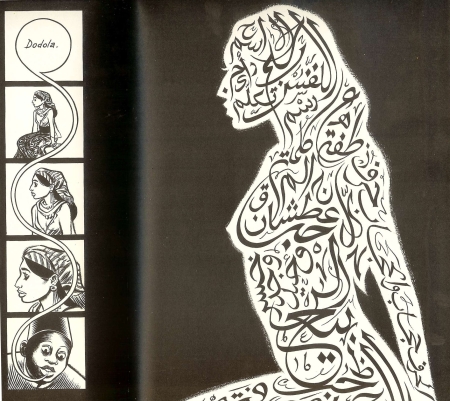
three panel sequence from Craig Thompson's Habibi
I just finished reading Habibi a new comic book novel by Craig Thompson. Thompson is one of the most masterful storytellers of the contemporary comics world. His work is very much for adults: no superheroes, mature themes (sex, religion), thoughtful, and moving. His novels are long and sweeping; Habibi is nearly 700 pages, every one of them precious.
His earlier semi-autobiographical novel Blankets is a favorite of mine, too, so I was eagerly awaiting the new piece. Habibi takes place in an unnamed middle eastern land. It’s the story of a young woman, Dodola, and her companion, Zam, also called Habibi. Dodola is sold into slavery, escapes, and runs away with Zam an abandoned child nine years younger than she. The two grow up taking care of each other, and their lives are intertwined throughout the novel.
There are lots of wonderfully big themes running through the book:
- water, rivers
- religion – especially the converging themes of Islamic and Biblical mythos
- coming of age, including the awkwardness of adolescence
- storytelling – both verbal and written
I am not going to recount the plot so much… but I do want to explore some of the lush and beautiful visual storytelling techniques that Craig Thompson engages.

Arabic border on page 248 of Craig Thompson's Habibi
I don’t know all the terminology for these sorts of elaborate patterns, but Thompson deploys them to great effect. Much of the story is told through conventional multi-comic-panel pages, but some of the more heroic or fantastic sequences expand into full pages these beautiful elaborate borders, which resemble Arabic tilework, architecture, textiles, patterns, etc.
In addition to Arabic patterns, Thompson frequently builds fabulous visuals using Arabic lettering:

Detail of page 404-405 of Craig Thompson's Habibi
The panel on the right is intensely beautiful, but what I really like here, and it’s something that Thompson plays with throughout Habibi, is the snaking tail of the word balloon on the left. Zam says “Dodola” and the ballon stem curves its way through the five vertical panels. It’s not even 100% clear what the S-curve means… It could be Zam’s gaze, an excitement (or tremble) in his voice, references to earlier snakes and Arabic lettering, a visual tool to make the sequence engaging, or all of the above… but it’s one of those storytelling vocabularies unique to comic books… and it’s sweet in the hands of a master like Thompson.
Sometimes Thompson employs fairly conventional panels. For example, see the three panel sequence at the top of this post (part of a standard 9-panel page, like here.) Even in these conventional panels, Thompson is great – playful, well-paced. I love the way Dodola reaches from panel two into panel one to grab Zam.
Frequently, Thompson plays with the rectangular grid, employing twists and turns on the convention. Often these are in the service of unconventional timing occurring, whether action, dream, recollection, story, etc.
Here’s a playful five-panel panel page, with unconventional panel outlines showing a frantic chase sequence:

Page 314 of Craig Thompson's Habibi
The sweep of the curves echoes the swinging of the axe-spear-thing – and the sweep of Zam dashing away from his pursuer. Not only are the illustrations great (I like the shadow in panel two and the hand grabbing the ledge-edge of panel three), but the whole page is composed with an overall symmetry.
Thompson also does a lot of great full-page panels. I’ll end with this one:

Page 429 of Craig Thompson's Habibi
It’s a lush underwater snapshot… with exquisite symmetry, detail, contrast… the sound effect “SPLOOSH!” is integrated into the motion of submergence… Thompson is a great artist, a great writer, and a great comic book creator.
Go get your hands on a copy of Habibi. You won’t be able to put it down.
Tags: comics, Craig_Thompson, Habibi
Leave a comment